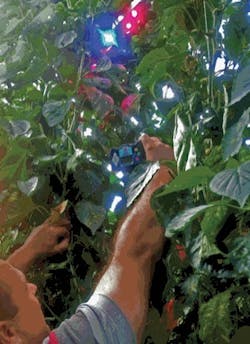The right ratio of blue and red LEDs boosts leaf growth and antioxidant compounds in lettuce

Cheongju, South Korea--Adding to the fast-growing body of knowledge on the use of LED illumination in horticulture, scientists at Chungbuk National University published a study in which they exposed red and green leaf lettuce to six different LED lighting treatments, then examined growth characteristics including the fresh and dry weights of shoots and roots, shoot-to-root ratio, total leaf area, and chlorophyll content. Chlorophyll fluorescence, antioxidant capacity, phenolic concentration, and flavonoid concentration were also measured in the study.
The scientists concluded that the growth-characteristic results for the two lettuce cultivars grown under various ratios of blue (456 nm) to red (655 nm) LEDs confirmed that red LED light improves lettuce growth rate. Blue:red ratios tested were 0:100, 13:87, 26:74, 35:65, 47:53, and 59:41.
The experiments confirmed that blue and red LEDs have a positive effect on the accumulation of antioxidant phenolic compounds and lettuce growth, respectively. "Red light irradiation in the absence of blue light was effective at stimulating the biomass accumulation of lettuce plants; however, this lighting alone induced abnormal leaf shape and had a negative effect on polyphenolics and antioxidant levels," the scientists say. They recommend a mixture of blue and red LEDs to enhance lettuce-crop quality and yield in closed-type plant-production systems; the best results for lettuce arose from the blue:red ratios 35:65, 47:53, and 59:41.
That makes scents
Past studies elsewhere have shown the beneficial effects of other LED wavelength bands on plant growth; for example, researchers from the U.S. Department of Agriculture (Beltsville, MD) have used UV LEDs emitting at about 290 nm (the UVB range) to make lettuce darker and redder, as well as to keep strawberries from getting moldy. For crops including petunia, tomato, strawberry, and blueberry, red and far-red LED light can be used to manipulate scents of the fruits and flowers.
For more info, see: http://hortsci.ashspublications.org/content/48/8/988.abstract
Source: http://ashs.org/pressrelease/index.php?option=com_content&view=article&id=1302:researchers-test-effects-of-leds-on-leaf-lettuce-&catid=1:hortscience&Itemid=3

John Wallace | Senior Technical Editor (1998-2022)
John Wallace was with Laser Focus World for nearly 25 years, retiring in late June 2022. He obtained a bachelor's degree in mechanical engineering and physics at Rutgers University and a master's in optical engineering at the University of Rochester. Before becoming an editor, John worked as an engineer at RCA, Exxon, Eastman Kodak, and GCA Corporation.